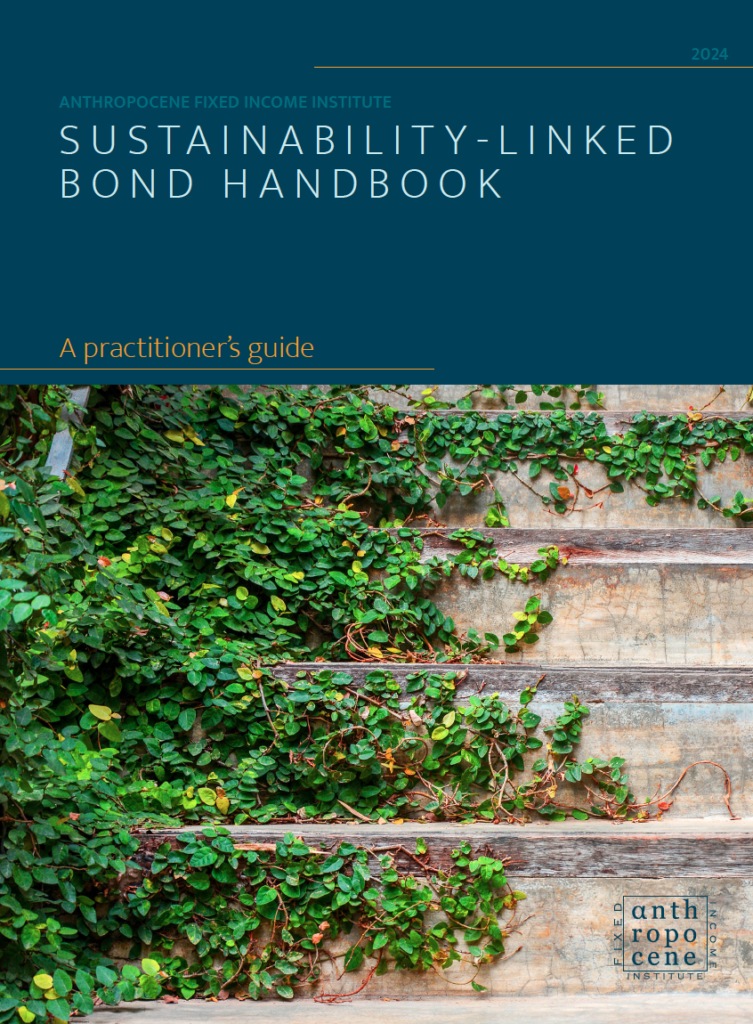The Anthropocene Fixed Income Institute (AFII) has published a Sustainability-linked bonds (SLB) handbook, which offers a practical overview of the market. This first-of-its-kind guide is intended to advance understanding of SLBs and help scale the market for these instruments.
“SLBs are a financial innovation with the potential to direct billions of dollars to the decarbonisation of the global economy. These bonds allow companies and countries to commit to and finance ambitious and holistic transition plans. However, as a new product, there have been some false starts and criticisms. Our goal is to equip market participants with the knowledge to identify and invest in ambitious SLBs that offer true financial and sustainability impact.”
– Ulf Erlandsson, AFII’s CEO and Founder
With analyses from AFII’s team of seasoned market professionals, including former portfolio managers and traders, the SLB Handbook distils extensive, original research into a practical guide for fixed income practitioners. It includes over 40 detailed case studies, providing readers with a solid foundation of real-world applications and evidence-based outcomes.
“A central theme of the Handbook is the strategic use of pricing mechanisms to design ambitious SLBs. Instruments designed this way can attract a broad spectrum of investors while also encouraging issuers to set stretch targets that increase their sustainability impact. The Handbook also includes guidance on the various ways in which SLBs can be deployed in fixed income strategies, from pure alpha generation to sustainability risk hedging.”
– Josephine Richardson, Managing Director and Head of Research at AFII
The first edition of the Handbook provides a technical guide that will help market participants to deploy SLBs that achieve attractive financial outcomes while delivering measurable impact. A central theme of the book is how pricing can be used to structure ambitious SLBs that will attract investors and, ultimately, scale the SLB market.
What are SLBs?
SLBs do not require the proceeds to be ring-fenced for specific purposes, as is the case with green bonds, but instead require the issuer to set specific key performance indicators (KPIs) tied to the business that they must meet within a specified time frame before the bond matures. Some common KPIs include a reduction in CO2 emissions or an increase in renewable energy production. In order to incentivise issuers to meet these targets, the SLBs are typically tied to a financial penalty. Most commonly SLBs have a ‘step up penalty’ meaning that if the issuer fails to meet the targets, it has to pay out a higher interest rate to investors.
As of November 2023, the global SLB market represented US$279 billion, totalling 768 bonds from 469 issuers. Non financial corporates dominate the SLB market, issuing 83% of SLBs in 2023. They are particularly popular in hard to abate sectors, such as utilities, fossil fuel companies and industrials, which can find it hard to ring-fence projects through green bonds.
Sustainability-Linked Bonds (SLBs) have a crucial part to play in unlocking the power of the largest pool of global capital – fixed income – to invest in and propel the climate transition. This handbook shows how SLBs can incentivise bond issuers to meet ambitious climate targets and achieve a lower cost-of-capital if they are structured correctly. At the same time, investors who believe that transitioning companies yield better returns or are lower risk, can position for this credibly through SLBs. SLBs carry the promise of bringing together investors and issuers on the urgent and necessary climate transition financing journey.
Debt contracts with these features can be appealing for a wide range of investors while also encouraging borrowers to set targets that increase their sustainability impact. If done well and ambitiously, SLBs should be very appealing investments from a financial as well as from a sustainability perspective. SLBs that offer a lot optionality should also offer a higher price. Moreover, SLBs can also be deployed in fixed income strategies in a range of ways, from pure alpha generation to sustainability risk hedging,” says Erlandsson.
